
築地 孫右衛門 ららぽーと門真店
Tsukiji magoemon
3.14
Moriguchi, Kadoma
「Seafood rice bowl」
1,000-1,999円
1,000-1,999円
Opening hours: 10:00~21:00(L.O.20:30) Business hours
Rest time: are subject to change, so please check with the store before visiting.
大阪府門真市松生町1-11 ららぽーと門真 3F
Photos
(20)


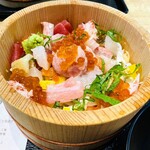

















Details
Reservation Info
No Reservations
Payment Method
Credit cards accepted
E-money accepted
QR code payment accepted
Private Dining Rooms
None
Smoking and Non-Smoking
No smoking at the table
Parking
Yes
Shared facilities
Comments
(12)
kinta198
3.70
After exploring the outlet, I felt like having seafood and decided to visit the food court. I ordered seafood hitsumabushi. Just like eel hitsumabushi, it came with dashi broth, but I separated it in a tea cup and poured soy sauce over it! The price was reasonable and it was delicious. I want to try different types next time! It was so good. Thank you for the meal.


たい〜人生の調味料は食にあり〜
3.30
Seafood Hitsumabushi restaurant located on the 3rd floor of Lalaport food court ✔️ Sea Treasure Hitsumabushi (large) ¥1,380. Hitsumabushi style meal where you can enjoy a seafood bowl, a seafood chirashi with plum accent, and finish with a flavorful ochazuke. If you want to try both the seafood bowl and the ochazuke, the price is reasonable. It may be a bit pricey, but still worth it. If you're craving a seafood bowl, the one on the 1st floor at Kuromon Market might be a better choice. Both places have a waiting time. This place also takes a bit of time to prepare the food, so there was a bit of a wait for the order (waited 30 minutes today). (They mention the waiting time). *The wasabi is spicy and the soy sauce is strong. Please be careful with the amount of condiments.


あもりママ
3.30
Second daughter and LaLaport! I thought it wouldn't be too crowded even though we arrived at 11:15, but the popular restaurants on the 1st floor were packed and the line at Sawada on the 3rd floor wasn't moving... So, we looked for a restaurant that wasn't in Tennoji and found this place. I ordered the Tsukiji seafood bowl and my daughter ordered the Hittsumabushi special, both for 1891 yen each (excluding tax). The fish was fresh and had no fishy smell. Even though my daughter doesn't like tuna, she finished all the tuna in the Hittsumabushi! The rice was lukewarm white rice, which was a relief because she doesn't like vinegared rice. I thought both dishes were equally good, but when I tried the broth from my daughter's Hittsumabushi, I felt like I lost (*´ω`*). It was delicious, but the prices are a bit high for me, considering that my salary hasn't increased much with the rise in prices... I wish it was a bit cheaper, but it was tasty, so next time I'll order the eel dish haha.




☆ダン☆
2.90
The steak at Honki no Steak Aoki was not enough for two people, so we also ordered a tuna and salmon rice bowl for 1180 yen at Tsukiji Maguroan Songoemon, which had an open seat right in front of us. We were called in about 5 minutes. When we opened the bowl, we found thinly sliced maguro and salmon on top of a bed of rice. In the center, there were ginger, shiso leaves, and wasabi. The portion seemed small, especially considering the price. We were satisfied because we had steak as well, but for an average person, it might not be enough. Given the portion size and price, we probably won't choose this restaurant again next time. Thank you for the meal.



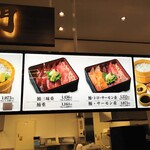
ke-kochin
3.10
During Golden Week at lunchtime, the wait time after ordering was less than 15 minutes. A bowl with various toppings such as tuna, eel, egg, shiso leaves, yellowtail, along with a pot of soup and pickled plum were served on a tray. The sweet egg omelette was a highlight of the seafood bowl at the food court. The total cost was 1380 yen including tax.


あー80007
3.80
There is also Mr. Maguro at Tsukiji! It was opened at Kadoma LaLaport! While wandering around the food court, the seafood hitsumabushi caught my eye immediately! The menu here is so stylish (just my taste). The unagi-don also looked very tempting, but I chose the seafood hitsumabushi! I went for the special one priced at 1,891 yen. Maybe because it's in a food court, it was actually quite affordable and worth it! It was delicious! Next time, I want to try the unagi-don! Thank you for the meal!

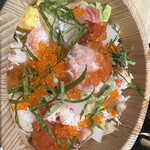

魔女様
3.50
Lunch at the food court of Mitsui Outlet Park Mihama, enjoying the famous Kaisen Hitsumabushi from Tsukiji Maguro Sambae for ¥1380 (tax included). I also had a seafood bowl and turned it into a refreshing seafood ochazuke by adding umeboshi and pouring dashi over it. It was delicious and reasonably priced.




さすらい講師
0.00
"Tsukiji Magoemon Lalaport Koshien Store" (Osaka, Koshien City), which is the 76th in the series of new store explorations to eat early at Lalaport Koshien's 3rd floor food court "FOOD TERRACE." The name of the store comes from Morison Uemon, as detailed below. The opening of the store is in "ZIPANGU," in other words, the ramen "Dotombori Kamukura." Just a little nitpicking here, a skilled chef with two Michelin stars carefully selected the ingredients. From the name and description of this store, you might get the impression that it is a "well-established famous store in Tokyo Tsukiji" opening in Kansai. However, this is just a hint at Tsukiji, and also a hint at Michelin stars. The store opened on November 21, 2020, followed by Mint Kobe Store on November 1, 2021, and Lalaport Shonan Hiratsuka Store on April 25, 2022. The order was not for a seafood bowl but for an Unadon for 2,190 yen. I also ate it at Lalaport Sakai, but was the total weight one kilogram? It looks exactly like the towering Eel and Rice Bowl at Izumo. As a bowl, it looks good and most importantly, it has a satisfying taste. The downside of this bowl is its difficulty to eat. In this food court, most menu items cost over 1,000 yen, so this dish is not that expensive. The downside of the bowl is its difficulty to eat. The bowl is too flat, so it's difficult to use the tea bowl and plate provided, and the spoon is more practical. (Side note) Legend of Morison Uemon and Tsukudani After the Incident at Honnoji Temple, Ieyasu Tokugawa, who was in Sakai, barely escaped to Okazaki with the help of Morison Uemon, the village headman of Tsukuda in Settsu Province, and the fishermen. Since then, there has been a connection. In 1590, when Ieyasu Tokugawa moved to Kanto, Morison Uemon and 33 fishermen were called to Edo. At that time, the advanced fishing techniques were from the Kansai region, where they were needed. The fishermen were allowed to fish anywhere in Edo and received generous protection, such as a permit from Ieyasu. They were given reclaimed tidal flats as a place to live, named after their hometown, Tsukuda Island, which still remains in the current place name. They were ordered to pay fish tribute to Edo Castle, and the fish that Ieyasu liked, Shirauo (white fish), was the main fish. They were free to sell other fish. Morison Uemon's second son, Kusabemon, opened a fish market, which is considered the origin of Nihonbashi Fish Market. Nihonbashi flourished until it moved to Tsukiji Market in 1923 after the Great Kanto Earthquake. Unsold small fish (miscellaneous fish) were sold as Tsukudani. Originally, the fishermen of Tsukuda Village had been using boiled small fish and shellfish as preserved food for fishing trips since their hometown, and in Edo, it was named Tsukudani after Tsukuda Island and became a marketable product. Tsukudani was accepted by the commoners of Edo due to its high preservability and low price, and it further spread throughout the country as a famous Edo souvenir for samurai returning to their hometowns during the Sankin-Kotai period, being taken back to various regions and becoming popular nationwide."




午前1時
0.00
This is Rinku Premium Outlets. The seafood menu seems to be authentic and appealing. We tried dishes like salmon and ikura parent-child bowl, Tsukiji seafood bowl, and eel and egg bowl, each ordering something different to share with the family. The eel and egg bowl was delicious, even the rice was tasty.
ハゲルナ
0.00
This is the food court at Lalaport Izumisano. I've never heard of Tsukiji Maguroemon before. But I like seafood, so I couldn't resist trying it. The Kaisen Hitsumabushi was not cheap, but it was delicious. Served in a wooden box, it had a luxurious feel to it.
勝手きままに
0.00
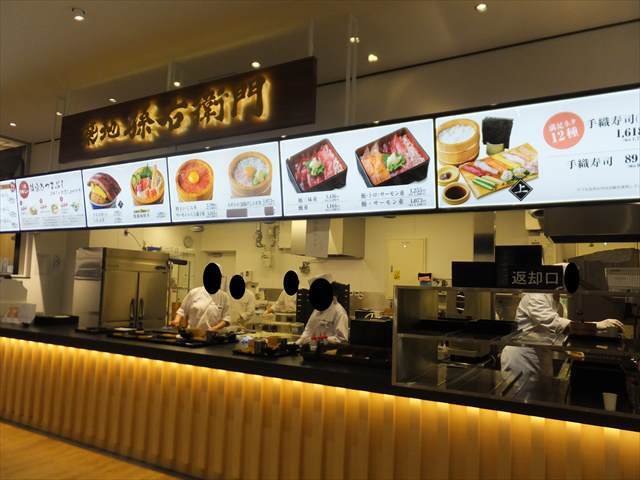
rumirumidayo
0.00
Seafood restaurant located in the food court of Lalaport Izumi, offering a luxurious Chirashi bowl surrounded by 15 types of fresh ingredients including shrimp, tuna, and conger eel. Although the portion of rice is slightly small, finishing with the melt-in-your-mouth fatty tuna will leave you feeling completely satisfied and happy.


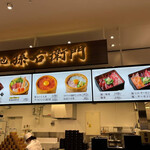
Email Login